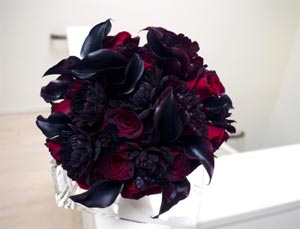3 Easy Techniques to Create Black Flowers

The dark shade of flowers becoming popular, either for a wedding bouquet or flower arrangements and centerpieces, for example, a blend of highly contrasting black and white.
A few flowers give the impression they are black on the grounds that their blooms are to a great degree dim red or dim purple, for example, the Schwarzwalder calla lily. However, if you want to get a truly black color you will have to help Mother Nature.
You can make your preferred black flower by following one of these three techniques, none of which is very hard to do. You can color the blossoms by putting the stems in color-enhanced water, dunk the sprouts in colored stain or splash the flowers with botanical paint.
1. How to Dye Flowers Black
Using food coloring or ink can be successful, but not as as effective as using professional floral dye. Professional dye products won’t restrain the blossoms’ water take-up, guaranteeing you get the longest vase life for your flowers.
To buy flower color, approach your florist to order it for you. Ask them which flowers are the best for this project. Some florists recommend picking white blooms, yet others recommend picking a darker shading, for example, red. You may need to try different things with both to figure out which one to use for your project.

- Leave the flowers out of water for no less than three hours once you get them home.
This way they will assimilate the color improved water all the more rapidly. - In a container sufficiently large to hold the flowers, add 2-3 teaspoons of floral dye to every quart of warm water (100-110 °F/37-43 °C). Blend the fluid altogether.
- Remove lower foliage from each stem. Cut stems at an edge with sharp shears.
- Put the stems into the dye solution. Leave them to sit in the water for 30 minutes to an hour.
- While you wait, prepare the vase. Add some flower additive blending it with the proper amount of water.
- At the point when enough time has passed, remove the flowers from the dye solution and then rinse the color off the stems.
- Transfer your bouquet to the vase.
The dark shade of your blooms will escalate as the color keeps going up the stem. In the case of coloring distinctive assortments, don’t anticipate that the shading will be retained at a similar rate. Woody stems, such as roses, take more time to take-up the color than green-stemmed blooms, such as carnations. Black roses additionally may not accomplish even coloring unless you keep up an even temperature of the dye solution while the stems are in the fluid.
Dispose of extra dye solution by pouring it over newspaper to soak it up. Then throw out the papers with your ordinary trash.

2. How to Dip Flowers for Black Blossoms
- Pick flowers with completely opened blooms so the color will have the capacity to coat every petal all the more effortlessly .
- Empty the liquid dye into a bucket or container with a huge opening to facilitate the plunging procedure.
- Dip each bloom into the solution for around 2 seconds.
- Shake off the excess dye, permitting the additional fluid to fall back.
- Rinse each bloom head under a faucet and shake again to remove the excess water.
- Allow flowers to dry before handling so that you don’t stain clothing or skin with wet dye.
If your flowers aren’t as dark as you would like, you can do-over the process once they are dry.
3. How to Spray Flowers to Create Black Blooms
Spraying flowers with floral spray paint is the least demanding approach to guarantee a profound, dark, reliable black shading. It’s likewise the messiest, so be set up before you begin by utilizing drop cloths or newspapers to shield your work space from overspray. Likewise, make sure that the place you work in is very much ventilated, at a moderate temperature (around 70 °F/21 °C) and not too humid. Regular spray paint is too harsh and overwhelming for sensitive flowers, so purchase one from your florist.


- Shake the can well, before and between uses.
- Turn the paint can spout to line up with the dark spot on the edge.
- Hold the can 15 to 18 inches from the blossom head.
- Spry each bloom, turning the bloom in your hand to get all sides and inside the petals.
- For darker shading, permit the paint to dry and then apply another coat.


